with contribution from members of the EURO2MOON Market & Business Working Group, especially Carlos Espejel (ispace), Bertrand Baratte (Air Liquide), and Pierre-Alexis Joumel (Airbus Defence & Space)
AMPLIFY VOL. 37, NO. 2

It’s not unthinkable that the headlines of 2050 could be reporting on a dynamic new economy on the Moon, with human settlers, incipient manufacturing facilities, growing transport infrastructure, and booming tourism. Or else it could be just written off as an eternal desert, far from Earth with only scientific — or military — value. Today, the jury is still out on how things will unfold.
Until recently, Moon exploration has been mainly the preserve of state-funded science. However, as the possibility of developing a future lunar economy — a self-sustaining and sustainable lunar ecosystem — starts to be taken more seriously, private investors beyond the narrow “space industry bubble” are beginning to show interest. For example, Japanese company ispace launched its HAKUTO-R M1 lunar-landing mission in 2022. Last year, well-known toymaker Tomy contributed to a lander successfully deployed from a governmental JAXA (Japan Aerospace Exploration Agency) lunar mission. More recently, US space companies Astrobotic Technology and Intuitive Machines both launched their missions to the Moon, albeit with mixed results.
Lunar economic development would require very high levels of capital investment over several decades and would reach far beyond the traditional scope of the space industry, involving sectors such as mining, telecommunications, manufacturing, farming, and others. Despite the major technical, financial, political, and even ethical issues still to be resolved, there could be great potential in growing a sustainable, peaceful, lunar economy.
Based on a recent study conducted by Arthur D. Little (ADL) with partners from Europe’s leading lunar industry association, EURO2MOON, this article briefly explores the business potential of developing lunar resources. At this embryonic stage, the aim is not to provide definitive answers but rather to increase understanding of underlying demand drivers, possible value chains, and areas of uncertainty. To illustrate the issues, we focus on one of the most important potential lunar markets: propellant production. Reaction engines using propellants will be key for powering vehicles, both for operations on the lunar surface and for space travel to and from Earth and the solar system.
The study followed a well-established six-step process:
-
Supply side. Summarize the potentially available lunar resources.
-
Demand side. Identify and model the drivers for demand, including assessing impact and uncertainty.
-
Scenarios. Develop potential scenarios to help visualize the future ecosystem.
-
Value chain. Propose a likely value chain structure for propellant production.
-
Use cases. Outline the highest-priority use cases for each scenario.
-
Demand projection. Estimate the likely ranges of propellant demand for these use cases.
This article is derived from a much more detailed scientific paper presented by EURO2MOON at the 2023 Aerospace Europe Conference.1
Available Resources on the Moon
Based on current scientific knowledge, which is still limited in extent, the Moon may be rich in resources that hold great potential for permanent settlement and commercial utilization. These include, among others, oxygen, hydrogen, aluminum, magnesium, and potentially water ice. The presence of potential water ice is perhaps surprising for nonexperts, but there is evidence to suggest it could exist in significant quantities at the Moon’s poles. As well as its value in supporting human life and numerous other manufacturing applications, it can be used to generate oxygen and hydrogen for propellant production. Indeed, many of the other minerals present on the Moon may also be used for propellant production.
As well as these so-called material resources, the Moon also provides valuable “immaterial” resources, which are also a key benefit for certain potential use cases. These include: low gravity (or microgravity), which is useful for the production of certain high-quality materials; abundant solar energy for power generation; extensive land for building equipment and real estate; and hard vacuum/low temperatures, which are valuable for running cryogenic and superconducting processes.
As such, propellant production is seen as a major application for in-situ resource utilization (ISRU). By harnessing local resources, ISRU can potentially reduce the reliance on Earth for propellant resupply. This can significantly enhance the sustainability and cost-effectiveness of space missions, as well as enable long-duration space exploration and sustainable presence in space. ISRU takes advantage of the lower gravity of the Moon to achieve greater operational efficiencies and to reach other orbits with less energy than Earth. ISRU has the potential to reinvent how we think about space missions and transportation in space, even in Earth orbit.
Key Drivers for Demand in Lunar Economy
To model the drivers for economic demand in the lunar economy, a top-down approach was taken, starting with identifying the range of likely end goals. As shown in Figure 1, five generic end goals were identified (scientific exploration, resource utilization, manufacturing, construction, and tourism) together with several support activities (transportation, positioning/navigating/timing [PNT] and observation, in-orbit services, and security). The achievement of each end goal will be determined by a range of different drivers. For example, achieving the goal of lunar manufacturing would be driven by human presence, positive economic interest, and the development of the necessary technology.
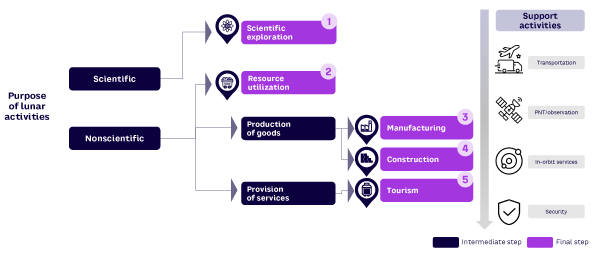
For propellant production, we are primarily interested in the resource utilization end goal. Our analysis for achievement of this goal identified seven macro-level drivers as being key, shown in the dark blue boxes in Figure 2.
Each of these seven drivers has different relative levels of uncertainty and impact on the achievement of propellant production. For example, having a “high cost of transportation to/from Earth” is fairly likely, and its impact on the extent of lunar resource extraction is also high.
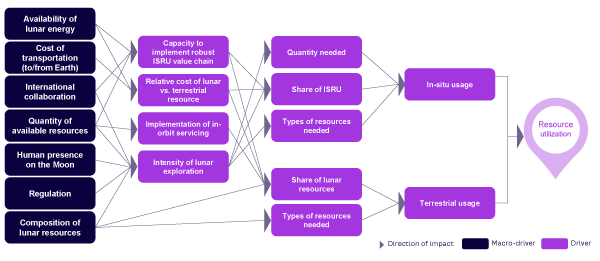
Figure 3 shows the ranking of all these drivers based on the two axes of impact and uncertainty. As shown in the figure, human presence, availability of lunar energy, and quantity of available resources are the three macro-drivers that emerge with the combination of highest impact/highest uncertainty:
-
Human presence. Human presence on the Moon significantly impacts the scale and scope of all lunar activities. However, the timeline, required investment, and necessary international cooperation for establishing a sustained human presence on the Moon are all highly uncertain.
-
Availability of lunar energy. Beyond solar power, other energy sources such as nuclear energy will be crucial to produce the power required by other activities (e.g., mining) with a reasonable logistic footprint. However, whether these will become available, and their maturity and extent, are uncertain.
-
Quantity of available resources. Although there is scientific evidence of the existence of lunar resources, as described above, there is still high uncertainty around its extent, distribution, quality, quantity, and accessibility.
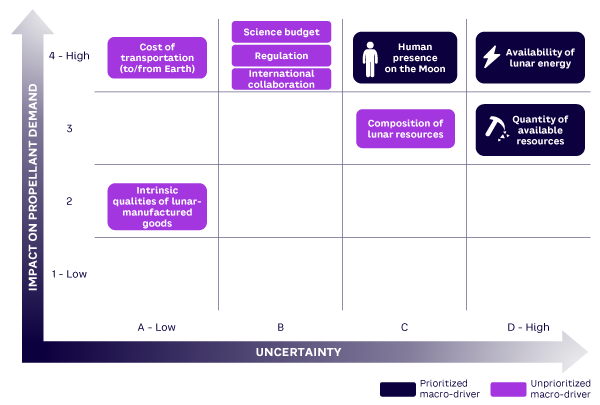
5 Scenarios for Future Lunar Development
The most useful future scenarios to consider for the broadest coverage are those that result from different combinations of the above three high-impact/high-uncertainty drivers. Those drivers with low uncertainty will need to be addressed in all possible futures, while those drivers with low impact are relatively less important. Five plausible scenarios emerged from the analysis (see Figure 4).
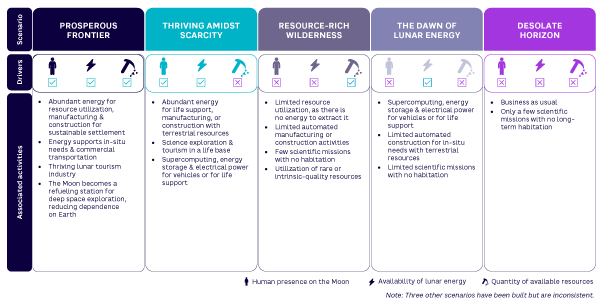
The first scenario, the Prosperous Frontier, is the most optimistic, with abundant energy, abundant resources for utilization, long-term habitation, and commercial trips between the Moon and Earth. In the Thriving Amidst Scarcity scenario, the lack of material resources restricts broader economic development, but there is still a human base supporting dynamic scientific and tourism activities. By contrast, the Resource-Rich Wilderness scenario envisages little, if any, permanent human settlement due to lack of energy, with activities restricted to selective utilization of rare available resources and targeting of scientific missions. The Dawn of Lunar Energy scenario similarly envisages restricted development, based on costly terrestrial resources. Finally, the Desolate Horizon scenario represents largely the current situation, with no further economic development and only occasional scientific missions.
It is immediately clear from the five scenarios that there is a huge variation in possible futures for lunar resource utilization. Nevertheless, understanding the drivers for these futures can help businesses better anticipate the implications of relevant events as they unfold over time.
What Would a Lunar Propellant Value Chain Look Like?
To help us assess the demand for lunar propellant across different scenarios, it is necessary first to model a preliminary propellant value chain. As shown in Figure 5,2-4 there are six main steps, beginning with resource exploration and moving through construction, extraction, processing and refinement, storage and liquefaction, and transportation.
Each of these steps would need its own enabling technologies (also shown in the figure). While some of these, such as transportation using rovers, have already been deployed on the Moon, others, such as microwave heating for lunar regolith processing, are still in the applied research and experimental development stages.
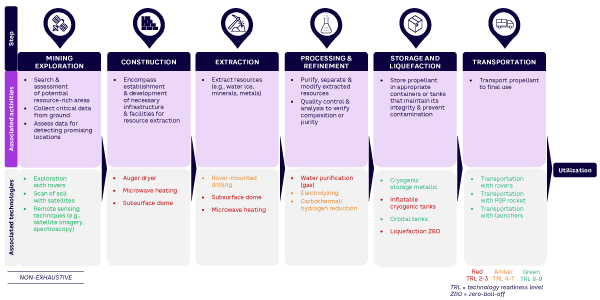
It is beyond reasonable doubt that this type of value chain would need to involve an ecosystem of players in different value chain positions. Understanding ecosystem roles and helping to enable ecosystem development will be important for any prospective investor or entrepreneur. One key consideration affecting attractiveness will be the extent to which innovative technologies developed for the lunar environment could be redeployed to advantage on Earth.
Use Cases for Lunar Propellant
The next step in the analysis was to identify and map the various use cases for lunar propellant. Using a range of sources, including EURO2MOON and ADL experts, 16 vehicle types were identified across a range of energy sources. These were classified in terms of how much power they needed and the duration of their use to fulfill their typical mission (see Figure 6).5-7
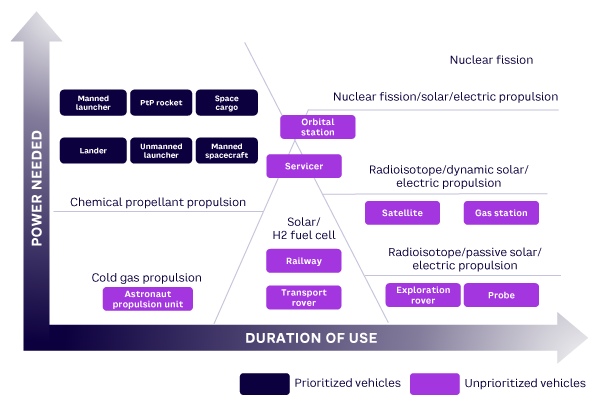
Given that oxygen is the most abundant and available resource, we decided to focus on chemical propellant propulsion in order to make a projection of the range of likely propellant demand across the different scenarios. In Figure 6, these are the six use cases in the top-left of the matrix. They include:
-
Manned launchers — specifically designed to transport astronauts from the Moon to space
-
Point-to-point (PtP) rockets — designed to transport passengers or payloads efficiently and rapidly between different locations on the Moon’s surface
-
Space cargo — the transportation of goods and supplies from space (orbit) to Earth, Mars, or farther in space
-
Landers — spacecraft designed to transport passengers or payloads from orbit to surface
-
Unmanned launchers — space vehicles designed to deliver payloads into space from Moon without the presence of human operators or crew onboard
-
Manned spacecraft — specialized vehicles designed to transport astronauts from space (orbit) to Earth, Mars, or farther
Projected Propellant Demand
The final step in the analysis was developing a projection for propellant demand (in this case, oxygen). This was done by summing the individual demands from each of the six use cases and making adjustments for each of the other scenarios. Starting with the most optimistic Prosperous Frontier scenario, assumptions were made about the number of missions (e.g., ones related to the number of satellite launches from the Moon, tourist loadings, Mars missions, number of bases) and the oxygen consumption per mission. Together, this yielded an estimate of the total oxygen demand. For the other four scenarios, adjustments were made to each of the assumptions based on the nature of the scenario. (Full details of the calculation methodology can be found in “A Prospective Market & Business Perspective on Lunar ISRU for Propellant Applications.”8)
Figure 7 shows the results of the calculations. As illustrated, the projected oxygen demand varies hugely from over 40 kt/year in the Prosperous Frontier scenario to a very small number in The Dawn of Lunar Energy scenario. This is perhaps to be expected, given the current high levels of uncertainty surrounding the future of lunar exploration and development.
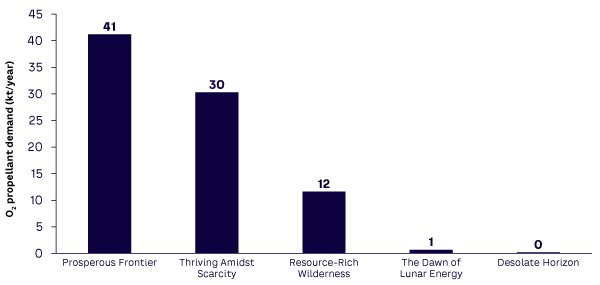
Conclusion & Key Takeaways
Ultimately, the projected value of oxygen propellant demand is only of secondary interest. More valuable is that the study demonstrated a systematic, thorough, and transparent way of dealing with the future potential of lunar development, in a situation where there are still large uncertainties.
The main challenge for businesses seeking to invest in the future lunar economy is basing their business cases on reliable long-term market forecasts in a nascent ecosystem. Identifying the main drivers of the lunar ecosystem and their main divergence points allows stakeholders to better account for the high levels of uncertainty.
This approach also helps build a comprehensive, high-level vision of the future ecosystem and the associated value chains. Once businesses have built such a vision, they are better able to keep the main underlying drivers under watch and refine their vision as their level of uncertainty reduces. This helps them gain early insights into how different factors will affect different parts of the value chain, resulting in different outcomes. It also shows more clearly which factors are less scenario-dependent than others — in other words, factors that could be addressed by “no regret” actions.
Finally, the study confirms that building a sustainable, peaceful lunar economy is going to be heavily dependent on strong international collaboration; robust principles around key issues such as sustainability, security, and ethics; and bold decision-making by public space agencies and businesses working in partnership. If this can be achieved, the benefits could be huge.
References
1 Ainardi, Matteo, et al. “A Prospective Market & Business Perspective on Lunar ISRU for Propellant Applications.” Proceedings from the Aerospace Europe Conference 2023 (Joint 10th European Conference for Aerospace Sciences/9th Council of European Aerospace Societies Conference), Lausanne, Switzerland, 9-13 July 2023.
2 Kornuta, David, et al. “Commercial Lunar Propellant Architecture: A Collaborative Study of Lunar Propel-lant Production.” Reach, Vol. 13, March 2019.
3 Sutton, George P., and Oscar Biblarz. Rocket Propulsion Elements. Wiley, 2016.
4 Weston, Sasha (ed.). “Small Spacecraft Technology State-of-the-Art Report: 2023 Edition.” NASA, February 2024.
5 Kornuta et al. (see 2).
6 Metzger, Philip T. “Economics of In-Space Industry and Competitiveness of Lunar-Derived Rocket Propellant.” Acta Astronautica, Vol. 207, June 2023.
7 Green, Robert D., and Julie E. Kleinhenz. “In-Situ Resource Utilization (ISRU) Living Off the Land on the Moon and Mars.” NASA, 21 March 2019.
8 Ainardi et al. (see 1).





